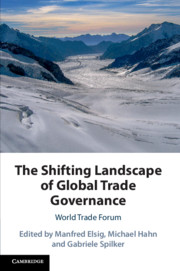Book contents
- The Shifting Landscape of Global Trade Governance
- The Shifting Landscape of Global Trade Governance
- Copyright page
- Contents
- Figures
- Tables
- Contributors
- Preface
- Abbreviations
- 1 Introduction
- Part I New and Old Challenges
- Part II Trade Policy and Trade-Related Concerns
- Part III Development Angles
- 11 The Trade-Migration Nexus from a Multilevel Perspective
- 12 TRIPS Implementation in Developing Countries
- 13 Investment Promotion and Facilitation for LDCs
- Part IV Diffusion across Economic Treaties
- Index
- References
11 - The Trade-Migration Nexus from a Multilevel Perspective
from Part III - Development Angles
Published online by Cambridge University Press: 05 August 2019
- The Shifting Landscape of Global Trade Governance
- The Shifting Landscape of Global Trade Governance
- Copyright page
- Contents
- Figures
- Tables
- Contributors
- Preface
- Abbreviations
- 1 Introduction
- Part I New and Old Challenges
- Part II Trade Policy and Trade-Related Concerns
- Part III Development Angles
- 11 The Trade-Migration Nexus from a Multilevel Perspective
- 12 TRIPS Implementation in Developing Countries
- 13 Investment Promotion and Facilitation for LDCs
- Part IV Diffusion across Economic Treaties
- Index
- References
Summary
International migration is a relative newcomer on the “trade and” agenda and has hitherto received relatively little attention in trade and migration studies alike. The inclusion of labour migration as one essential mode of cross-border trade in services, so-called Mode 4 in the GATS, opened the agenda for more far-reaching developments at the level of regional and bilateral free-trade agreements . This chapter shows that this deepening of the trade-migration nexus is intricately linked to power shifts in the global economy and the rise of regionalism. For the international trade regime in 2025, this means that, in combination with the ongoing power transitions, the trade-related mobility agenda is likely to expand beyond what the former sponsors of the GATS agreement, the European Union (EU) and the United States, originally intended.
- Type
- Chapter
- Information
- The Shifting Landscape of Global Trade GovernanceWorld Trade Forum, pp. 255 - 274Publisher: Cambridge University PressPrint publication year: 2019
References
References
List of Interviews
Interview Permanent Mission of Indian to the WTO, Geneva, February 2013.
Interview Federation of Indian Chambers of Commerce and Industry (FICCI), New Delhi, India, January 2014.
Interview Ministry of Commerce and Industry, Department of Commerce, New Delhi, India, January 2014.
Interview ASEAN Secretariat, AEC Department, Jakarta, Indonesia, June 2014.
Interview Ministry of Manpower and Transmigration, Jakarta, Indonesia, June 2014.
Interview Ministry of Trade Indonesia, Services division, Jakarta, June 2014.
Interview Expert IOM Buenos Aires and Regional Office for South America, Buenos Aires, July 21, 2014.
Interview Ministry of Labour, Buenos Aires, July 23, 2014.
Interview University of Lanus, Buenos Aires, July 22, 2014.
Interview National Direction for Migration, Buenos Aires, July 22, 2014.
Interview Ministry of Development, Industry and Foreign Trade, Brasilia July 29, 2014.
Interview Ministry of Trade, Services Division, Jakarta, Indonesia, October 2014.
Interview Ministry of Trade and Industry Singapore, September 2015.
Interview Ministry of Trade, Industry, and Energy, South Korea, Seoul, 2015.
Interview Academic Expert, Beijing, September 2015.
Interview ILO Experts, Beijing, September 2015.
Interview IOM Experts, Beijing, September 2015.
Interview Policy Expert, Beijing, September 2015.
Interview Government Official, Switzerland 2017.

